
The Uffizi Gallery is a prominent art museum located adjacent to the Piazza della Signoria in the Historic Centre of Florence in the region of Tuscany, Italy. One of the most important Italian museums and the most visited, it is also one of the largest and best known in the world and holds a collection of priceless works, particularly from the period of the Italian Renaissance.

Alessandro di Mariano di Vanni Filipepi, known as Sandro Botticelli, was an Italian painter of the Early Renaissance. Botticelli's posthumous reputation suffered until the late 19th century, when he was rediscovered by the Pre-Raphaelites who stimulated a reappraisal of his work. Since then, his paintings have been seen to represent the linear grace of late Italian Gothic and some Early Renaissance painting, even though they date from the latter half of the Italian Renaissance period.
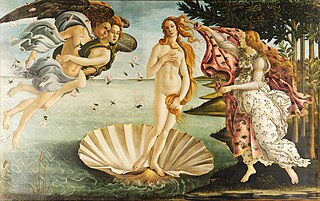
The Birth of Venus is a painting by the Italian artist Sandro Botticelli, probably executed in the mid 1480s. It depicts the goddess Venus arriving at the shore after her birth, when she had emerged from the sea fully-grown. The painting is in the Uffizi Gallery in Florence, Italy.

Domenico di Tommaso Curradi di Doffo Bigordi, professionally known as Domenico Ghirlandaio, also spelled as Ghirlandajo, was an Italian Renaissance painter born in Florence. Ghirlandaio was part of the so-called "third generation" of the Florentine Renaissance, along with Verrocchio, the Pollaiolo brothers and Sandro Botticelli. Ghirlandaio led a large and efficient workshop that included his brothers Davide Ghirlandaio and Benedetto Ghirlandaio, his brother-in-law Bastiano Mainardi from San Gimignano, and later his son Ridolfo Ghirlandaio. Many apprentices passed through Ghirlandaio's workshop, including the famous Michelangelo. His particular talent lay in his ability to posit depictions of contemporary life and portraits of contemporary people within the context of religious narratives, bringing him great popularity and many large commissions.

Filippino Lippi was an Italian painter working in Florence, Italy during the later years of the Early Renaissance and first few years of the High Renaissance.

Filippo Lippi, also known as Lippo Lippi, was an Italian painter of the Quattrocento and a Carmelite Priest.
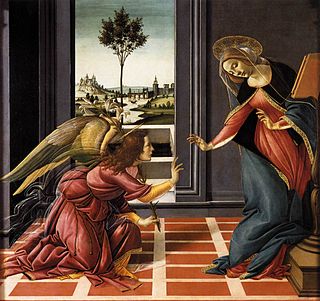
The Cestello Annunciation, is a painting in tempera on panel made in 1489 by Sandro Botticelli. It was painted for the patron Benedetto di Ser Giovanni Guardi to adorn the church of the Florentine monastery of Cestello, which is now known as Santa Maria Maddalena de'Pazzi.
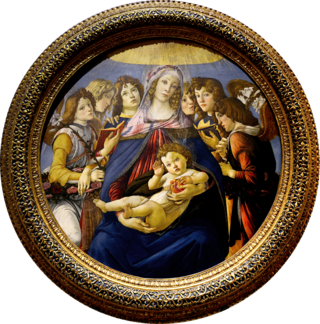
The Madonna of the Pomegranate was painted in circa 1487 with tempera on a wood panel by Sandro Botticelli. It is now in the Uffizi in Florence. Sandro Botticelli was a leading Italian Renaissance artist from Florence, Italy. The Madonna (art) uses the circular format, better known as a tondo, which focuses the attention on the main characters, the Virgin Mary and baby Jesus, who are surrounded symmetrically by angels on each side. Botticelli's use of tempera grassa give the characters a real look, better known as a "naturalistic" style, which is common during the Renaissance. The Virgin Mary is holding baby Jesus gently in her arms while holding a pomegranate in her left hand.

Madonna in Glory with Seraphim is a painting by the Italian Renaissance painter Sandro Botticelli, executed c. 1469–1470. It is housed in Galleria degli Uffizi.

Florentine painting or the Florentine School refers to artists in, from, or influenced by the naturalistic style developed in Florence in the 14th century, largely through the efforts of Giotto di Bondone, and in the 15th century the leading school of Western painting. Some of the best known painters of the earlier Florentine School are Fra Angelico, Botticelli, Filippo Lippi, the Ghirlandaio family, Masolino, and Masaccio.
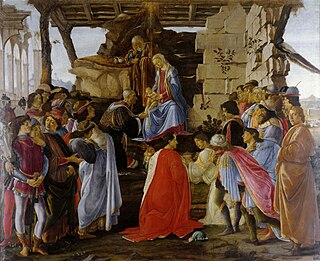
The Adoration of the Magi is a painting by the Italian Renaissance master Sandro Botticelli. Botticelli painted this piece for the altar in Gaspare di Zanobi del Lama's chapel in Santa Maria Novella around 1475. This painting depicts the Biblical story of the Three Magi following a star to find the newborn Jesus. The image of the altarpiece centers on the Virgin Mary and the newborn Jesus, with Saint Joseph behind them. Before them are the three kings who are described in the New Testament story of the Adoration of the Magi. The three kings worship the Christ Child and present him with gifts of gold, frankincense and myrrh. In addition, the Holy Family is surrounded by a group of people who came to see the child who was said to be the son of God.
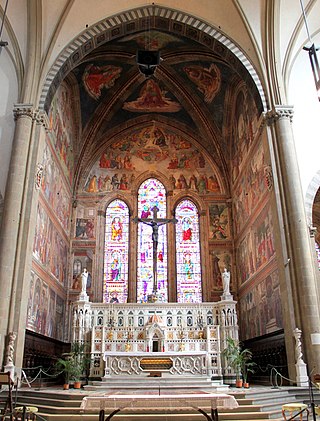
The Tornabuoni Chapel is the main chapel in the church of Santa Maria Novella, Florence, Italy. It is famous for the extensive and well-preserved fresco cycle on its walls, one of the most complete in the city, which was created by Domenico Ghirlandaio and his workshop between 1485 and 1490.
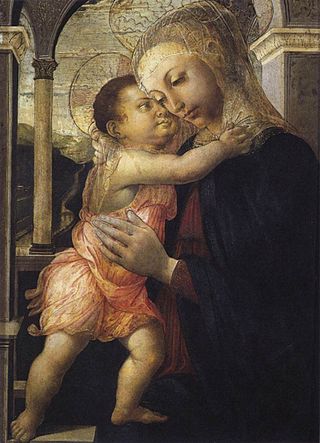
The Madonna della Loggia is a painting attributed to the Italian Renaissance artist Sandro Botticelli, dating to c. 1467. A tempera on panel work, it is located in the loggia of Uffizi, Florence, Italy.

The Virgin and Child with the Infant Saint John the Baptist is a tempera painting on wood executed by the Italian Renaissance master Sandro Botticelli and his studio. The tondo, painted in Florence between the years of 1490 and 1500, addresses a central theme of the Italian Renaissance art: the divine motherhood. The work is now in the São Paulo Museum of Art.
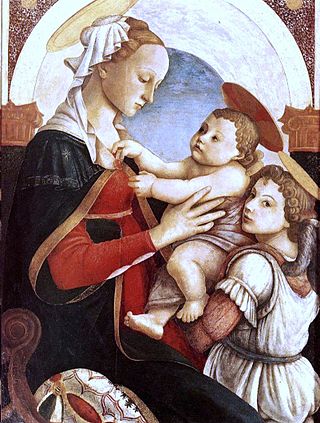
The Madonna and Child with an Angel is a painting by the Italian Renaissance painter Sandro Botticelli, c. 1465–1467. It is housed in Spedale degli Innocenti of Florence.

Primavera, is a large panel painting in tempera paint by the Italian Renaissance painter Sandro Botticelli made in the late 1470s or early 1480s. It has been described as "one of the most written about, and most controversial paintings in the world", and also "one of the most popular paintings in Western art".

Madonna with Child is a painting by the Italian Renaissance artist Filippo Lippi. The date in which it was executed is unknown, but most art historians agree that it was painted during the last part of Lippi's career, between 1450 and 1465. It is one of the few works by Lippi which was not executed with the help of his workshop and was an influential model for later depictions of the Madonna and Child, including those by Sandro Botticelli. The painting is housed in the Uffizi Gallery, Florence, Italy, and is therefore commonly called “The Uffizi Madonna” among art historians.
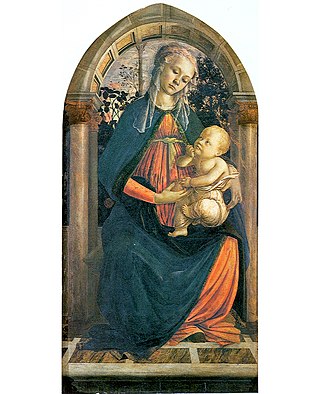
The Madonna of the Rose Garden is a tempera on panel painting made by Sandro Botticelli, whose date of between 1469 and 1470 makes it one of his earliest paintings. It is now in the Uffizi Gallery in Florence.
Lucrezia Buti was an Italian nun, and later the lover of the painter Fra Filippo Lippi. She is believed to be the model for several of Lippi's Madonnas.

The Mystical Nativity or Adoration in the Forest was painted by Fra Filippo Lippi around 1459 as the altarpiece for the Magi Chapel in the new Palazzo Medici in Florence. It is now in the Gemäldegalerie, Berlin, with a copy by another artist now hanging in the chapel. It is a highly individual depiction of the familiar scene of the Nativity of Jesus in art, placed in a mountainous forest setting, with debris from woodcutting all around, rather than the familiar stable in Bethlehem, and with the usual figures and animals around the mother and child replaced by others.





















